Your Trimble GNSS receiver: Protection against GNSS spoofing
Trimble® Maxwell™ 7 technology adds several technical innovations that provide protection from the increasing threat of false GNSS signals and improve the performance of Trimble GNSS receivers.
These false, or “spoofed,” signals can lead to a receiver inaccurately calculating positions, potentially resulting in errors spanning several kilometers. This should not be confused with jamming, which also disrupts positioning by transmitting strong undesired signals that overload the GNSS receiver’s signal processing engine. However, in the jamming scenario, while the receiver has difficulty calculating a position, it will generally not be in the wrong location.

What is GNSS spoofing?
GNSS receivers track low-power signals transmitted from satellites. With the availability of low-cost programmable radios, it is now possible to develop a transmitter that will broadcast a spoofing signal a receiver will try to use instead of the true signal.
Depending on the sophistication of the spoofer, this can cause various positioning and timing errors. While Trimble currently does not encounter spoofing in its high-precision applications, such activities may increase in the coming years.
What is Trimble doing to mitigate spoofing?

Trimble GNSS receivers with Maxwell 7 technology include a number of features to protect them from GNSS spoofing. Maxwell 7 technology is based around Trimble’s next-generation ASIC, RF and processor developments. The technology provides robust precision positioning by fusing all GNSS constellation signals together with additional sensor data. The defense against spoofing is currently handled at the following levels:
1. Rejection of spoofed signals in the digital signal processing (DSP)
Advanced tracking algorithms detect if multiple signals are received for each satellite and ensure only the true signal is tracked. The spoofed signal generally shows as a stronger secondary correlation peak (due to the signal being stronger from the spoofing transmitter), which the tracking channel isolates and rejects from reaching the positioning algorithm.
2. Satellite data checking
By keeping a historical record of the orbital parameters transmitted by each satellite, Trimble can detect if these change unexpectedly or fall outside reasonable bounds. Maxwell 7 technology can also cross-check orbital data from multiple sources (for example, GPS L1 is compared to L2C and L5).

3. Receiver autonomous integrity monitoring (RAIM)
Used in the aviation industry for some time, RAIM provides an essential aspect in detecting and rejecting satellite data that may be being spoofed. With more measurements than unknowns, the receiver has the ability to detect a satellite measurement that does not fit into the positioning solution. If such a measurement is detected, RAIM will then test each satellite in the given constellation in order to find the most likely outlier.
RAIM is also calculated between GNSS constellations with complete systems being rejected if necessary. This assumes a simplistic spoofing event where a subset of constellations are affected. For example, if only the GPS constellation is spoofed, then by calculating multiple position solutions from subsets of measurements from GLONASS, BeiDou, Galileo, QZSS, NavIC and SBAS, the receiver can determine what GPS measurements need to be removed.
4. Position sanity checks
If the receiver detects that positions have jumped by an unrealistic amount since the last computed position, this is also a valuable indicator of spoofing.
5. Limiting satellite search window
Utilizing recent tracking information, the receiver will limit the search window for reacquiring satellites.
Continuing to evolve to mitigate spoofing challenges
The occurrence of spoofing will increase in the future, and incidents have the potential to disrupt critical applications. To prepare for this, Trimble’s precision GNSS receivers include Maxwell 7 technology to identify and remove unwanted signals. As spoofing becomes more sophisticated, Trimble technology will continue to evolve to mitigate these challenges. Users can trust in the advanced protection and accuracy of their Trimble high-precision positioning solution.
Contact your Trimble Authorized Distributor or visit the Trimble website to learn more about Trimble Geospatial GNSS receivers